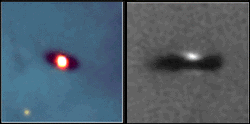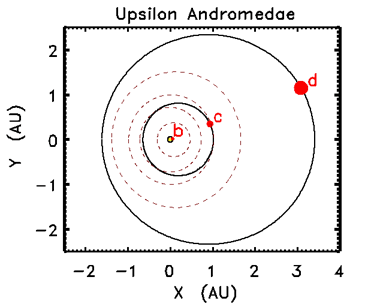StarChild Question of the Month for June 1999
Question:
Can you tell me about the other solar systems being discovered?

Answer:
During the past few years, researchers have detected over a dozen planets
orbiting sunlike stars. The first was reported in October 1995 by Michel
Mayor and Didier Queloz of the Geneva Observatory in Switzerland. While
observing the star 51 Pegasi, they noticed a change in the light from the
star - its light repeatedly shifted back and forth between the blue and red
ends of the electromagnetic spectrum. The timing of this Doppler shift
implied that the star was "wobbling" a little because of a closely orbiting
planet. In fact, the planet appeared to be revolving around the star every
4.2 days. Shortly thereafter, a survey of over a hundred other sunlike
stars performed by the team of Geoff Marcy and Paul Butler at San Francisco
State University and the University of California at Berkeley, turned up
six more such planets. Of those, one planet circling the star 16 Cygni B
was independently discovered by astronomers William D. Cochran and Artie P.
Hatzes of the University of Texas McDonald Observatory. Since 1996, the
announcement of the detection of new planets has become fairly
routine....but always exciting!
|

This image of sections of the Orion Nebula shows stellar
formation under way. Located in the Milky Way about1,500 light-years from
Earth, the nebula formed from collapsing gas clouds, yielding many new
stars. Among the new stars at least 153 show "protoplanetary disks" which
are believed to be embryonic solar systems. Shown are views of two of the
disks: (left) one is seen from above and (right) one is viewed edge-on.
Both images reveal gas and dust that should eventually form planets,
circling million-year-old (new!) stars.
Image Credit: Mark McCaughrean Max Planck Institute For Astronomy,
c. Robert O'Dell Rice University and NASA
|
Want to know how astronomers detected the extrasolar planets?
It is not easy to detect another planet so far away from Earth. Unlike
stars which are fueled by nuclear reactions, planets only reflect the
optical light of their stellar companion. In our solar system, for example,
the Sun outshines its planets about one billion times in visible light.
Because of the distant planets' faintness near the brightness of the nearby
star, astronomers have had to devise clever methods to detect them.
Currently, the most successful approach is based on the fact that a nearby
planet will cause the star to wobble back and forth just a bit as the
planet revolves around it. Astronomers can detect this tiny wobble and then
calculate the orbit and mass of the object which is causing it. Even using
this technique, however, it is still not easy to detect planets around
other stars. Consider this: someone looking at our Sun from 30 light-years
away would see it wobbling in a circle whose size would be about as big as
a quarter viewed from 10,000 kilometers away!
Yet this tiny wobble of the star can be detected by the Doppler shift of
the starlight. As the star sways to and fro relative to Earth, its light
waves become cyclically stretched, then compressed--shifting alternately
toward the red and blue ends of the spectrum. From that cyclical Doppler
shifting, astronomers can retrace the path of the star's wobble and, from
Newton's law of motion, compute their masses, orbits and distances from
their host stars.
What have astronomers been able to detect so far?
Of 16 such planets found around solar-like stars, their masses range from
about a half to five times that of Jupiter, their orbital periods span 3.3
days to about 15 years, and their distances from their host stars extend
from less than one twentieth of Earth's distance to the Sun to about 2.5
times that distance.
In March 1999, Marcy and Butler announced the detection of the first true
other "solar system" in which they found evidence of 3 planets orbiting a
single star. The star is called Upsilon Andromedae. A schematic diagram of
the orbits for the 3 planets detected around Upsilon Andromedae is shown
below.
|

The red dots mark the orbits of planets b, c, and d. The dashed
circles show the orbits of Mercury, Venus, Earth and Mars (inside to
outside, respectively) overplotted to give the scale of the orbits.
Image Credit: G. Marcy, D. Fischer, R. Noyes, S. Korzennik, P. Nisenson,
A. Contos, and T. Brown |
Drawing from the data on planets found so far, scientists believe they will
continue to discover other planets orbiting sun-like stars; many of these
planets will be the size of Jupiter, some will be the size of Earth. It may
be that as many as 10 percent of all stars in our Galaxy host planetary
companions. Based on this estimate, 10 billion planets would exist in our
Milky Way Galaxy alone!
For additional information on planets around other stars, see:

The StarChild site is a service of the
High Energy Astrophysics Science Archive
Research Center (HEASARC),
within the
Astrophysics Science Division (ASD) at
NASA/
GSFC.
StarChild Authors: The StarChild Team
StarChild Graphics & Music: Acknowledgments
StarChild Project Leader: Dr. Laura A.
Whitlock
Curator: J.D. Myers
Responsible NASA Official: Amber Straughn
![]()
![]()